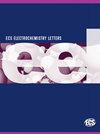N. Georgescu, Adriel Jebin Jacob Jebaraj, D. Scherson
{"title":"水电解质中氧还原电催化剂性能指标的关键评价","authors":"N. Georgescu, Adriel Jebin Jacob Jebaraj, D. Scherson","doi":"10.1149/2.0021506EEL","DOIUrl":null,"url":null,"abstract":"Certain aspects of the interpretation of rotating ring-disk electrode, RRDE, data for the oxygen reduction reaction, ORR, in aqueous electrolytes have been examined. In particular, the classical mechanism proposed by Damjanovic et al. [J. Chem. Phys. 45, 4057 (1966)] predicts that at a fixed potential, a plot of the ratio of the disk to the ring currents for the ORR vs ω−1/2, where ω is the rotation rate of the disk, should be linear. According to this analysis, the slope of this line is proportional to k3/XH2O2 , where k3 is the rate constant for the reduction of solution phase hydrogen peroxide, H2O2(aq), and XH2O2 is the fraction of the disk current that generates H2O2(aq), the magnitude of which can be determined from the line intercept. Illustrations of this theoretical framework are provided for ORR data reported in the literature for experiments involving Pt-based electrodes and collected in our laboratories for Pt in aqueous acidic solutions. Critically emphasized is the need to perform ring-disk measurements at multiple rotations rates in order to determine reliable values of XH2O2 , which can be used as figures of merit for ranking the efficacy of ORR electrocatalysts. © The Author(s) 2015. Published by ECS. This is an open access article distributed under the terms of the Creative Commons Attribution 4.0 License (CC BY, http://creativecommons.org/licenses/by/4.0/), which permits unrestricted reuse of the work in any medium, provided the original work is properly cited. [DOI: 10.1149/2.0021506eel] All rights reserved.","PeriodicalId":11470,"journal":{"name":"ECS Electrochemistry Letters","volume":"57 1","pages":""},"PeriodicalIF":0.0000,"publicationDate":"2015-01-01","publicationTypes":"Journal Article","fieldsOfStudy":null,"isOpenAccess":false,"openAccessPdf":"https://sci-hub-pdf.com/10.1149/2.0021506EEL","citationCount":"9","resultStr":"{\"title\":\"A Critical Assessment of as a Figure of Merit for Oxygen Reduction Electrocatalysts in Aqueous Electrolytes\",\"authors\":\"N. Georgescu, Adriel Jebin Jacob Jebaraj, D. Scherson\",\"doi\":\"10.1149/2.0021506EEL\",\"DOIUrl\":null,\"url\":null,\"abstract\":\"Certain aspects of the interpretation of rotating ring-disk electrode, RRDE, data for the oxygen reduction reaction, ORR, in aqueous electrolytes have been examined. In particular, the classical mechanism proposed by Damjanovic et al. [J. Chem. Phys. 45, 4057 (1966)] predicts that at a fixed potential, a plot of the ratio of the disk to the ring currents for the ORR vs ω−1/2, where ω is the rotation rate of the disk, should be linear. According to this analysis, the slope of this line is proportional to k3/XH2O2 , where k3 is the rate constant for the reduction of solution phase hydrogen peroxide, H2O2(aq), and XH2O2 is the fraction of the disk current that generates H2O2(aq), the magnitude of which can be determined from the line intercept. Illustrations of this theoretical framework are provided for ORR data reported in the literature for experiments involving Pt-based electrodes and collected in our laboratories for Pt in aqueous acidic solutions. Critically emphasized is the need to perform ring-disk measurements at multiple rotations rates in order to determine reliable values of XH2O2 , which can be used as figures of merit for ranking the efficacy of ORR electrocatalysts. © The Author(s) 2015. Published by ECS. This is an open access article distributed under the terms of the Creative Commons Attribution 4.0 License (CC BY, http://creativecommons.org/licenses/by/4.0/), which permits unrestricted reuse of the work in any medium, provided the original work is properly cited. [DOI: 10.1149/2.0021506eel] All rights reserved.\",\"PeriodicalId\":11470,\"journal\":{\"name\":\"ECS Electrochemistry Letters\",\"volume\":\"57 1\",\"pages\":\"\"},\"PeriodicalIF\":0.0000,\"publicationDate\":\"2015-01-01\",\"publicationTypes\":\"Journal Article\",\"fieldsOfStudy\":null,\"isOpenAccess\":false,\"openAccessPdf\":\"https://sci-hub-pdf.com/10.1149/2.0021506EEL\",\"citationCount\":\"9\",\"resultStr\":null,\"platform\":\"Semanticscholar\",\"paperid\":null,\"PeriodicalName\":\"ECS Electrochemistry Letters\",\"FirstCategoryId\":\"1085\",\"ListUrlMain\":\"https://doi.org/10.1149/2.0021506EEL\",\"RegionNum\":0,\"RegionCategory\":null,\"ArticlePicture\":[],\"TitleCN\":null,\"AbstractTextCN\":null,\"PMCID\":null,\"EPubDate\":\"\",\"PubModel\":\"\",\"JCR\":\"\",\"JCRName\":\"\",\"Score\":null,\"Total\":0}","platform":"Semanticscholar","paperid":null,"PeriodicalName":"ECS Electrochemistry Letters","FirstCategoryId":"1085","ListUrlMain":"https://doi.org/10.1149/2.0021506EEL","RegionNum":0,"RegionCategory":null,"ArticlePicture":[],"TitleCN":null,"AbstractTextCN":null,"PMCID":null,"EPubDate":"","PubModel":"","JCR":"","JCRName":"","Score":null,"Total":0}
引用次数: 9
A Critical Assessment of as a Figure of Merit for Oxygen Reduction Electrocatalysts in Aqueous Electrolytes
Certain aspects of the interpretation of rotating ring-disk electrode, RRDE, data for the oxygen reduction reaction, ORR, in aqueous electrolytes have been examined. In particular, the classical mechanism proposed by Damjanovic et al. [J. Chem. Phys. 45, 4057 (1966)] predicts that at a fixed potential, a plot of the ratio of the disk to the ring currents for the ORR vs ω−1/2, where ω is the rotation rate of the disk, should be linear. According to this analysis, the slope of this line is proportional to k3/XH2O2 , where k3 is the rate constant for the reduction of solution phase hydrogen peroxide, H2O2(aq), and XH2O2 is the fraction of the disk current that generates H2O2(aq), the magnitude of which can be determined from the line intercept. Illustrations of this theoretical framework are provided for ORR data reported in the literature for experiments involving Pt-based electrodes and collected in our laboratories for Pt in aqueous acidic solutions. Critically emphasized is the need to perform ring-disk measurements at multiple rotations rates in order to determine reliable values of XH2O2 , which can be used as figures of merit for ranking the efficacy of ORR electrocatalysts. © The Author(s) 2015. Published by ECS. This is an open access article distributed under the terms of the Creative Commons Attribution 4.0 License (CC BY, http://creativecommons.org/licenses/by/4.0/), which permits unrestricted reuse of the work in any medium, provided the original work is properly cited. [DOI: 10.1149/2.0021506eel] All rights reserved.

 求助内容:
求助内容: 应助结果提醒方式:
应助结果提醒方式:


